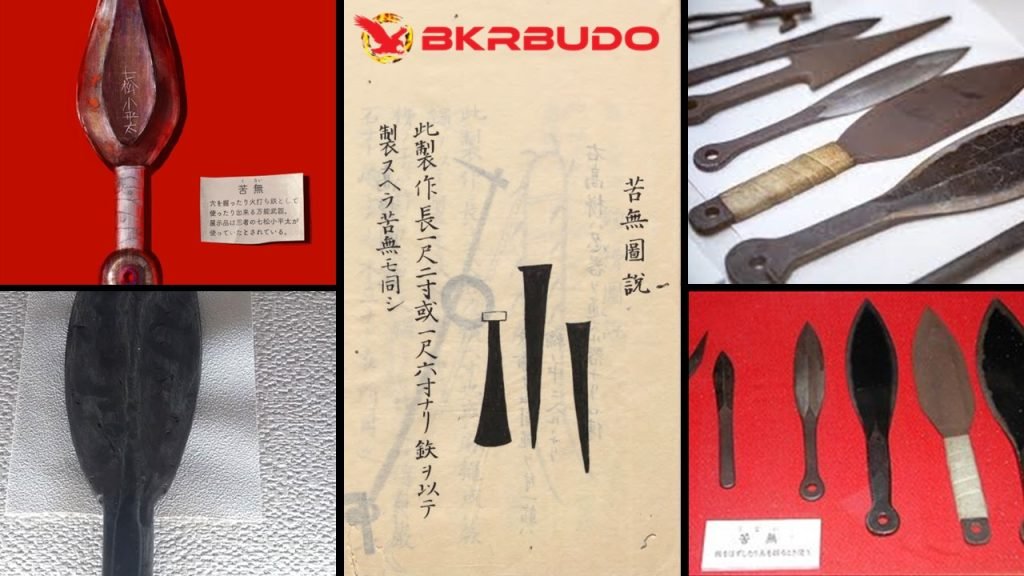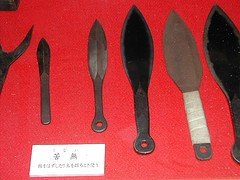The kunai serves as a captivating symbol of the shinobi’s resourcefulness and adaptability, embodying their ability to repurpose everyday items for unconventional tasks. Originally conceived as a humble gardening tool with a leaf-shaped blade and handle, the kunai’s widespread availability during the Warring States and Edo periods made it a prime candidate for inclusion in the versatile Shinobi toolkit.
This unassuming tool, when wielded by a warrior, transcended its agrarian origins and became indispensable for an array of tasks beyond its intended use. Its adaptability allowed covert agents to overcome common challenges, such as climbing, as the flat, iron claw-like shape facilitated scaling walls and navigating challenging terrains. Moreover, the kunai’s transformation into a dual-function instrument showcased the shinobi’s ingenious approach to combat.
The kanji representation for Kunai “苦無” adds a layer of philosophy, suggesting a commitment to efficiency and discretion in its application. Translated as “able to die without suffering,” it implies a mindset inherent to the shinobi’s clandestine operations.
Historical texts such as the “Bansenshukai” and “Ninpiden,” underscore the kunai’s significance in the shinobi’s arsenal. The “Bansenshukai” provides insights into various ninjutsu techniques, acknowledging the kunai’s role in infiltration, combat, and survival. In Hattori Hanzo’s “Ninpiden,” the kunai is referred to as “宮内,” further emphasizing its importance in their toolkit.
The kunai’s two distinct sizes, “大苦無” (large kunai, approximately 13-15 cm) and “小苦無” (small kunai, around 8-10 cm), highlight its adaptability to diverse situations. This adaptability extends to its role as a survival tool, resembling a modern-day survival knife, with its flat design and sturdy construction enabling effective digging during covert operations.
The ring-shaped rear of the kunai adds another layer of versatility, allowing ninjas to pass a string or rope through it. This transformed the kunai into a makeshift grappling hook or a tool for securing items.
The smaller kunai, known as “飛苦無” (tobikunai), were adapted for throwing, resembling shuriken in function. This showcases the shinobi’s capacity to repurpose tools for both close quarters combat and ranged attacks.
Interestingly, the kunai’s iron construction rendered it an unexpected yet practical application as a frying pan. This illustrates their adaptability and knack for making the most of limited resources. In addition to its role in climbing and combat, the kunai could serve as a striker with flint, producing sparks to start fires. This unexpected utility highlights the shinobi’s practical approach to leveraging the tools at their disposal for a wide range of tasks, including the essential ability to create fire for warmth, cooking, and signaling.
In contemporary fiction, the kunai often takes on a role like the bo shuriken, further amplifying its legendary status. Examples like NARUTO showcase imaginative uses, such as attaching explosive tags for a lethal impact on adversaries.
In essence, the kunai encapsulates the Shinobi ethos—resourcefulness, adaptability, and the art of turning the ordinary into the extraordinary—making it an enduring symbol of ninja ingenuity.
Sean Askew
Dōtō 導冬 Winter’s Guide
Resources:
Ninja no Seikatsu山口正之『忍者の生活』雄山閣出版、1981年
万川集海 登器 第十八編Bansenshukai Vol. 18 – Climbing Tools






